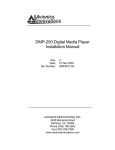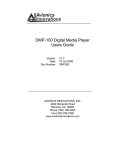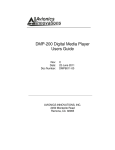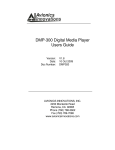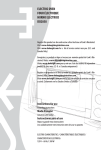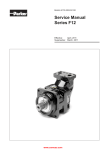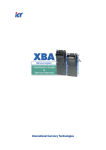Download Avionics Innovations DMP-100 - Digital Player Installation guide
Transcript
DMP-100 Digital Media Player Installation Guide Version: Date: Doc Number: V1.7 07 Dec 2006 DMP010 AVIONICS INNOVATIONS, INC. 2450 Montecito Road Ramona, CA 92065 Phone (760) 788-2602 Fax (760) 789-7098 www.avionicsinnovations.com Revision History Version Date V1.0 05-Jan-02 Initial Release SB V1.1 10-Jun-02 First production release SB V1.2 30-Jul-02 Added GPS Monitor screen SB V1.3 11-Sep-02 -Clarified pull-down resistors for discrete triggers. -Added remote operations of PAUSE input. SB V1.4 14-Jan-03 Added Jog Mode description to discrete triggers 6 and 7 SB V1.5 14-Sep-03 - Added remote volume control to Jog Mode Added elapsed time display option in Setup SB - Added Ext Pause signal type option Added “Busy goes active for:” option Added dedicated annunciator option for Trigs 1, 2 and 3 Added “Test All Outputs” function Added “Test All Inputs” function Added installation checkout procedure Added External Dimensions drawing Added Wire Interconnect drawing SB -Improved behavior of external Pause for better operation with cabin PA Systems. SB V1.6 20-Oct-06 V1.7 07-Dec-06 DMP-100 INSTALLATION GUIDE P/N DMP010 V1.7 Description - By PAGE 2 OF 20 Table of Contents Revision History................................................................................................2 Table of Contents .............................................................................................3 1.0 Introduction....................................................................................5 1.1 Description .......................................................................................5 1.2 Scope ...............................................................................................5 1.3 Package Contents ...........................................................................5 2.0 Mechanical ....................................................................................6 2.1 Specifications...................................................................................6 2.2 Mounting Considerations ................................................................6 3.0 Electrical ........................................................................................6 3.1 General.............................................................................................6 3.2 Connection to Aircraft Power ..........................................................6 3.3 Inputs................................................................................................7 3.3.1 Dimmer.........................................................................................7 3.3.2 Remote Pause/Play Button.........................................................7 3.3.3 Discrete Triggers .........................................................................8 3.3.4 Jog Mode .....................................................................................9 3.3.5 Dedicated Annunciators for Triggers 1, 2 and 3 ........................9 3.3.6 GPS Data.....................................................................................9 3.4 Outputs.............................................................................................9 3.4.1 Audio ............................................................................................9 3.4.2 Discrete ......................................................................................10 3.5 Connector Pinouts.........................................................................11 DMP-100 INSTALLATION GUIDE P/N DMP010 V1.7 PAGE 3 OF 20 4.0 Setup Mode .................................................................................12 4.1 Entering and Exiting Setup Mode .................................................12 4.1.1 Discrete Triggers 1 Through 7 – Active Level..........................12 4.1.2 External Pause – Active Level ..................................................12 4.1.3 External Chime Length..............................................................12 4.1.4 Display Brightness.....................................................................12 4.1.5 “LOUD” Volume Level ...............................................................13 4.1.6 PLAY Screen Text.....................................................................13 4.1.7 GPS Status ................................................................................13 4.1.8 External Pause Signal Type......................................................14 4.1.9 Configuration of the BUSY Output............................................14 4.1.10 Dedicated Annunciators for Triggers 1, 2 and 3 ......................14 4.1.11 Test External Outputs................................................................15 4.1.12 Test External Inputs...................................................................15 5.0 Installation Checkout Procedure.................................................15 6.0 Troubleshooting and Error Messages ........................................16 6.1 Troubleshooting.............................................................................16 6.2 Error Messages .............................................................................17 7.0 Drawings......................................................................................18 7.1 Mechanical Drawing......................................................................18 7.2 Electrical Interconnect ...................................................................18 DMP-100 INSTALLATION GUIDE P/N DMP010 V1.7 PAGE 4 OF 20 1.0 Introduction 1.1 Description The DMP-100 Digital Media Player is a self-contained unit which stores and replays prerecorded audio tracks. The audio tracks are encoded in “Motion Picture Expert Group (MPEG) Level 3” format, commonly referred to as “MP3”. Audio files are stored in a removable Compact Flash™ memory card which is prepared and installed by the user. Audio tracks are selected via a single rotary pushbutton on the front panel of the DMP100. Optionally, the DMP-100 may be connected to a maximum of seven external discrete trigger inputs, each of which can be configured in software to select a particular audio track. In addition, the RS232 data from a panel-mount GPS may be connected to the DMP-100 to allow triggering of audio files based on geographic position. The DMP-100 accepts a power input of between 10VDC and 35 VDC and provides a single pair of ground-referenced stereo line-level audio output signals. The DMP-100 has been designed and tested to the Environmental Specifications of RTCA DO-160D. An Environmental Qualification Form which describes the various parameters and the levels to which they were tested is available upon request from Avionics Innovations. 1.2 Scope This document describes the installation and initial checkout of the DMP-100 Digital Media Player. It may be used to support all installations, including those intended for initial Type or Supplemental Type Certification approvals. 1.3 Package Contents Before beginning the installation, verify that the following items are present: Qty Part No. 1 1 10000 DMP059-00 16109-00 16113-00 16111-00 DMP057 DMP010 DMP020 DMP030 DMP058 1 DMP-100 INSTALLATION GUIDE P/N DMP010 V1.7 Description Digital Media Player main unit DMP-100 Installation Kit, consisting of: (1ea) 25-Pin D-Sub Mating Connector (1ea) 25P Backshell (25ea) Female Pins (1ea) CompactFlash™ Memory Card (1ea) DMP-100 Installation Guide (1ea) DMP-100 Operators Guide (1ea) DMP100 Card Prep Software (OPTIONAL) USB reader/writer for CompactFlash™ cards PAGE 5 OF 20 2.0 Mechanical 2.1 Specifications The DMP-100 is fully contained within a 2-inch (5cm) high standard DZUS mount enclosure. Height: Width: Depth*: Weight: 2.0 in. 5.75 in. 5.0 in. 3.25 in. 0.75 lb (5.1 cm) (14.6 cm) (12.7 cm) (8.26 cm) (350 g) Front Panel System Enclosure * Connector shell protrudes 0.25” (0.64 cm) beyond system enclosure. Allow an additional 2.5” (6.35 cm) behind unit for mating connector and wiring. 2.2 Mounting Considerations The DMP-100 should be installed in a normally heated, pressurized section of the aircraft, however the unit contains no moving parts and does not require special vibration isolation. The unit may be mounted in an auxiliary area of the instrument panel, in a pedestal, or anywhere in the aircraft cabin outside of the cockpit. In a severe vibration environment, the unit should not be mounted vertically with the front panel facing down, to ensure that the memory card does not accidentally vibrate loose. Otherwise, the DMP-100 may be installed in any orientation and at any angle. 3.0 Electrical 3.1 General The following guidelines should be used when installing the DMP-100: ♦ ♦ ♦ 3.2 All wiring to be installed in accordance with FAA AC-4313-1A, Chapter 11, Sect. 2 All non-audio wiring to be MIL-W-22759 unless otherwise specified All audio wiring to be MIL-C-27500 shielded unless otherwise specified Connection to Aircraft Power The DMP-100 accepts a wide range of input voltage directly, without the need for converters or configuration changes. Minimum input: 8.0 VDC Maximum input: 35.0 VDC (1.0 Amp @ 8.0 VDC) (0.1 Amp @ 35 VDC) Nominal input: 14 VDC / 0.5 Amp 28 VDC / 0.25 Amp Aircraft power must be supplied via a 2 Amp resettable circuit breaker. DMP-100 INSTALLATION GUIDE P/N DMP010 V1.7 PAGE 6 OF 20 3.3 3.3.1 Inputs Dimmer The vacuum-fluorescent display on the DMP-100 can be set to one of four different levels of brightness in Setup Mode. Alternatively, the brightness level may be selected via the external dimmer input. Three different inputs are provided for each of the three common types of dimmer busses: 0-5VDC, 0-14VDC and 0-28VDC. Connect the aircraft dimmer signal to only one of these inputs. The two remaining unused inputs must remain unconnected. If an external dimmer input is to be used, enter Setup Mode (power up with the knob depressed, release when the display first lights up) and rotate the knob until “Disp. Brightness” is displayed. Push the knob repeatedly until <EXT. DIMMER> is displayed. To exit Setup Mode, simply cycle the power. Note that the factory default setting is for a fixed 100% brightness, with the dimmer input ignored. 3.3.2 Remote Pause/Play Button An external input is provided which can either emulate the front panel pushbutton, or can be used only to pause or resume playback. When set to “Edge-Activated”, the Remote Pause/Play input going active will immediately pause or resume the playback of any audio track in progress. In addition, if the knob has been turned so that a desired track is displayed (i.e. “queued up”), activating the Remote Pause/Play input will cause the track to begin playing. In these situations, the remote Pause/Play performs exactly like the front panel pushbutton. This is especially useful in single-pilot helicopter applications. If the remote pushbutton is mounted on or near the cyclic, the pilot can control the audio without releasing the flight controls. After playback of each audio track, the DMP-100 display automatically “points” to the next track on the memory card. Thus, the pilot can simply press the remote button after each track to initiate playback of the next audio track. The Remote Pause/Play input can be configured in Setup Mode as active high or active low. It can also be configured as either an “edge-activated” or a “level-activated” signal: • Edge-Activated When set to “edge-activated” (the default setting), the remote pushbutton works exactly like the front panel knob. Pause/Play function is toggled each time the signal changes from inactive to active, and new track playback may be started from the remote pushbutton as well. For example, if set up as Active Low, the Pause/Play will toggle each time a grounding pushbutton is pressed. Releasing the button has no effect. • Level-Activated This setting is intended for use when the remote Pause/Play input is connected to a cabin PA system’s KEY signal, to momentarily pause the DMP-100 playback while the PA is in use. If a track is playing, the DMP-100 will be PAUSED for as long as the Pause/Play signal is active, and will resume playing when the signal returns to inactive. If the DMP-100 is either idle or paused when the remote Pause/Play signal changes, it has no effect. DMP-100 INSTALLATION GUIDE P/N DMP010 V1.7 PAGE 7 OF 20 Like the discrete trigger inputs, Remote Pause/Play is floating and must be pulled up or down with an external resistor, depending on the desired active state. The input signal may vary between 0V and 35 VDC: levels above 3.5 VDC will be interpreted as “high”, while levels below 3.5 VDC will be “low”. When Edge-Activated is selected, the Remote Pause/Play input works in parallel with the front panel knob – playback may be paused via one and resumed via the other. Unlike the front panel knob, however, playback mode cannot be cancelled by holding the Remote Pause/Play input active. 3.3.3 Discrete Triggers Seven discrete trigger inputs are provided, each of which can be assigned to a particular audio track via the CardPrep software. When a trigger input becomes active, the corresponding audio track is played. Each input can be configured independently in Setup Mode as active high or active low. Triggers 6 and 7 can have a special function – see “Jog Mode” below. If more than one trigger input becomes active at the exact same time, the higher number input has priority. For example, if Trigger 5 and Trigger 3 become active simultaneously, the track assigned to Trigger 5 is played and Trigger 3 is ignored. The trigger inputs are floating, and must be pulled up or down externally depending on the desired active state. Inputs may vary between 0V and 35 VDC: levels above 3.5 VDC will be interpreted as “high”, while levels below 3.5 VDC will be “low”. Example: Active Low The annunciator lamp functions as a pull-up resistor. If a lamp is not used, it must be replaced by a resistor (1/4 W, 10K to 47K Ohms) Example: Active High The annunciator lamp functions as a pull-down resistor. If a lamp is not used, it must be replaced by a resistor (1/4 W, 10K to 47K Ohms). DMP-100 INSTALLATION GUIDE P/N DMP010 V1.7 PAGE 8 OF 20 3.3.4 Jog Mode If enabled on the memory card using the CardPrep software, Jog Mode causes four of the available seven trigger inputs to be redefined: - Triggers 6 and 7 are used to remotely step the DMP-100 through its menus. This is particularly useful for helicopter installations or any installation where the pilot needs to be able to quickly step back or ahead through the playlists and select a new track. - Triggers 1 and 2 are used to decrement or increment the volume level. Each activation of the trigger simulates a push-and-turn of one knob click. If Jog Mode is to be used, it is recommended that Triggers 1, 2, 6 and 7 each be wired to a snap-action momentary pushbutton. They may be configured as either active high or active low, as desired. Trigger 6 simulates a counterclockwise knob turn followed by a button press (stepping BACK through the playlists), while Trigger 7 simulates a clockwise knob turn (stepping FORWARD through the playlists) followed by a button press. See the DMP-100 User Guide; document DMP020, for complete details on the operation of Jog Mode. 3.3.5 Dedicated Annunciators for Triggers 1, 2 and 3 In some applications, it may be desirable to install dedicated pushbuttons for certain tracks. For example, pushbuttons could be labeled “Takeoff Briefing”, “Turbulence Briefing” and “Landing Briefing.” A dedicated annunciator can be installed with each button and can be configured to illuminate whenever the corresponding audio track is playing. This configuration is selected in Setup mode. See the Setup description on page 14. 3.3.6 GPS Data The DMP-100 can receive RS-232 or RS-422/485 serial data from panel-mount GPS receivers. This feature allows an audio track to be assigned to a latitude/longitude trigger via the CardPrep software. The GPSIN pin should be connected to either the GPS receiver’s RS232 out pin, or to RS422 “Data HI” or RS-485 “Data B”. The GPS DATA IN pin will accept either TTL level signals (0-5VDC) or RS-232 level signals (-10 to +10 VDC). The DMP-100 is compatible with the data from most models of Garmin, UPS/AT (Apollo/II Morrow), and Honeywell (Allied Signal/Bendix-King) panel-mount receivers. For Northstar receivers, please contact Avionics Innovations. 3.4 3.4.1 Outputs Audio The DMP-100’s stereo audio outputs are ground-referenced, line-level signals with a typical signal level of 1.8 V p-p. If isolation is required, an audio isolation transformer such as a Triad SP-50 or a Magna-Tek TY-141P must be provided externally. Volume level is selected from the front panel by the user, and stereo balance is selectable from setup mode. DMP-100 INSTALLATION GUIDE P/N DMP010 V1.7 PAGE 9 OF 20 3.4.2 Discrete Two discrete outputs are provided for interfacing external equipment. BUSY and CHIME are both open-collector outputs capable of sinking 1 Amp each. Maximum input voltage is 35 VDC on each. By default, BUSY is active anytime the DMP-100 is producing audio. However, the installer may configure BUSY to go active only for speech tracks, only for music tracks, for all types of tracks, or even to never go active at all. BUSY can be used to drive an audio switching relay, enable an external amplifier, or even to light a remote annunciator. If “Dedicated Annunciator Mode” is enabled for Triggers 1, 2 and 3, then BUSY has a different function. In this mode, BUSY is one of the three separate annunciators that indicate when Triggers 1, 2 or 3 are currently playing. CHIME goes active when a speech track has been selected or triggered, but the actual playback does not begin until CHIME goes inactive. The length of time CHIME remains active is selected in Setup Mode. CHIME can be used to enable an external chime or tone generator, to annunciate the fact that a speech message is about to begin. CHIME does not go active when a music track has been selected. DMP-100 INSTALLATION GUIDE P/N DMP010 V1.7 PAGE 10 OF 20 3.5 Connector Pinouts Pin Name Description 1 PWR Aircraft power, 10-35 VDC 2 PWR Aircraft power, 10-35 VDC 3 TRIG1 External trigger input 1 4 TRIG2 External trigger input 2 5 TRIG3 External trigger input 3 6 TRIG4 External trigger input 4 7 TRIG5 External trigger input 5 8 TRIG6 External trigger input 6 9 TRIG7 External trigger input 7 10 PAUSE External PAUSE/PLAY command 11 TRIG1_Active 12 GND Aircraft power return 13 GND Aircraft power return 14 TRIG2_Active The audio track associated with External trigger input 2 is playing, if configured 15 BUSY/ TRIG3_Active BUSY output, OR the audio track associated with External trigger input 3 is playing, if configured 16 CHIME CHIME output, open collector 17 AUDL Audio output, left channel 18 AGND Audio ground 19 AUDR Audio output, right channel 20 AGND Audio ground 21 DIM5 Dimmer input, 0-5VDC* (see note) 22 DIM14 Dimmer input, 0-14VDC* (see note) 23 DIM28 Dimmer input, 0-28VDC* (see note) 24 GPSIN RS-232 or RS-422/485 GPS serial data in The audio track associated with External trigger input 1 is playing, if configured NOTE: connect only one dimmer input, leave the others N/C DMP-100 INSTALLATION GUIDE P/N DMP010 V1.7 PAGE 11 OF 20 4.0 Setup Mode 4.1 Entering and Exiting Setup Mode Setup Mode is entered via the following steps: 1. Turn the unit off by removing power (there is no ON/OFF switch) 2. Depress and hold the front panel knob. 3. Apply power while continuing to hold in the front panel knob. 4. Release the knob when the display first lights up. After the 5-second intro screen, the first Setup Mode item is displayed. Setup Mode is exited by simply cycling power to the unit. Turning the knob once Setup Mode has been entered allows selection of the following setup items: 4.1.1 Discrete Triggers 1 Through 7 – Active Level The current active level of each of the seven discrete triggers, TRIG1 through TRIG7 is displayed. Pushing the front panel knob toggles each between “ACTIVE HIGH” and “ACTIVE LOW”. The new settings are immediately written to permanent memory – no explicit “save” action is required. 4.1.2 External Pause – Active Level The current active level of each of the external PAUSE input is displayed. Pushing the front panel knob toggles each between “ACTIVE HIGH” and “ACTIVE LOW”. The new setting is immediately written to permanent memory – no explicit “save” action is required. 4.1.3 External Chime Length The CardPrep software offers the user the option of activating an external chime prior to playing a speech track. The “EXT CHIME LENGTH” setup item determines how long the unit waits, with the CHIME signal asserted, before de-asserting the CHIME signal and playing the speech track. Pushing the front panel knob cycles EXT CHIME LENGTH from 0 to 9 seconds. CardPrep also offers the option of an “internal” chime, which is simply a selected MP3 file (usually a recording of a chime of some type) that is played before each speech track. Note that if a card specifies an internal chime, the CHIME output is not activated. 4.1.4 Display Brightness The DMP-100’s display can be set to one of four brightness levels, or can be set to allow an external dimmer input to select one of the four levels. Each push of the front panel knob cycles between 100%, 75%, 50%, 25% and EXT DIMMER. DMP-100 INSTALLATION GUIDE P/N DMP010 V1.7 PAGE 12 OF 20 4.1.5 “LOUD” Volume Level The playback volume level is normally set by turning the front panel knob while holding the knob pushed in. However, the CardPrep software allows the user to designate any track to be played at a “LOUD” volume setting. This is normally applied to speech tracks such as important safety messages. For example, if the DMP-100 is playing background music and the operator has set the volume to an unobtrusive level, the safety message can be played at a higher volume and the previous volume level will be restored when the music resumes. This setup item allows you to select the volume level which will be set if a track is played which has the “LOUD” volume attribute enabled. Pressing the front panel knob will start playback of a sample speech track, which loops continuously. Turning the knob will adjust (and display) the volume setting which will then be retained as the “LOUD” volume level. The “LOUD” volume setting is also used when an internal chime is played. 4.1.6 PLAY Screen Text The DMP-100 can display one of two types of screens while an audio track is playing. The default, as of Version 1.10 firmware, is an elapsed time display which shows the length of time the track has been playing. The second type of display are “Prompts” which cycle through helpful suggestions of user interface options. Each push of the front panel knob toggles between the selections of each type of display. 4.1.7 GPS Status To aid with installation troubleshooting, this screen presents a continuously-updated message describing the state of the GPS data input. One of three messages will be displayed: Message Description no data rec’d No serial GPS data is being received at all. Check power and wiring. data OK, no sig Valid serial data is being received from the GPS, but the GPS lat/lon is not valid. This is usually due to the GPS antenna not having a clear view of the sky. It does indicate that the wiring is probably OK. data/signal OK Valid serial data is being received, and the GPS is reporting a valid position. Note: The DMP-100 will take 5 to 10 seconds to respond to a change in the GPS data. DMP-100 INSTALLATION GUIDE P/N DMP010 V1.7 PAGE 13 OF 20 4.1.8 External Pause Signal Type The external Play/Pause input signal can be treated as either an “EDGE” or a “LEVEL”. If “EDGE“ is selected, the play/pause function will toggle each time the external button is pressed-and-released. If “LEVEL” is selected, the DMP-100 will remain paused as long as the external button is held down, and will resume when the button is released. Press the button to toggle between “EDGE” and “LEVEL”. The factory default value is “EDGE”. 4.1.9 Configuration of the BUSY Output The BUSY Output can be configured to go active under one of the following conditions: • Any time a SPEECH track is playing • Any time a MUSIC track is playing • Any time a track is playing, regardless of the track type (factory default value) • BUSY never goes active Press the button to cycle through these choices. When the desired choice is displayed, simply cycle power to the DMP-100 or select a different SETUP category. 4.1.10 Dedicated Annunciators for Triggers 1, 2 and 3 This page allows the selection or deselection of “Dedicated Annunciator Mode” for Triggers 1, 2 and 3. When enabled, this mode causes a separate discrete annunciator to illuminate whenever the audio track for that trigger is playing. A particular installation could include up to three dedicated pushbuttons for (particular briefing tracks, background music, etc) along with an annunciator to indicate when that trigger is active. Press the button to toggle between “DEDICATED ANN.” (this mode is selected) and “NO ANNUNCIATOR” (this mode is not selected). The factory default value is “NO ANNUNCIATOR”. Notes: • The annunciator will illuminate whenever the associated track is playing, even if it was not initiated by the discrete trigger. For example, if a “Prepare to Land” briefing track is tied to Trigger 1, the Trigger 1 annunciator will illuminate even if the track is selected from the DMP-100 front panel. • The BUSY annunciator is redefined as TRIG3_ACTIVE when this mode is selected. DMP-100 INSTALLATION GUIDE P/N DMP010 V1.7 PAGE 14 OF 20 4.1.11 Test External Outputs This page allows the installer to cycle through all the DMP-100 external outputs, setting and clearing each one in turn. This function is used during the installation checkout procedure, and may be used any time an external output needs to be tested. Each press of the button will activate one output and clear all others except the “All OFF” selection, which turns off all outputs. 4.1.12 Test External Inputs This page allows the installer to test the seven external trigger inputs and the external Play/Pause input. The display shows which input, if any, is currently active. If more than one input is active, the display will show only the highest priority input. Play/Pause is the highest priority, followed by Trigger 7, then Triggers 6 through 1 in descending order. If an input appears to have the wrong polarity, be sure the active levels are set correctly (see page 12 for more information on setting active levels for inputs). 5.0 Installation Checkout Procedure After all wiring is double-checked, especially the power and ground connections, the following procedure should be performed to verify external connections: 1. Press and hold the button while turning on power. Release the button when the DMP-100 display first lights up. 2. The DMP-100 will be in SETUP mode. Advance through all the setup items as described above, and set the options to match your installation. Do NOT select the setup item: “Set LOUD volume level” unless you have a memory card installed that has been prepared using the supplied CardPrep software. 3. Turn the knob to display the SETUP item labeled “Test Ext Outputs”. Press the button repeatedly to cycle through the various external outputs. Confirm that all attached equipment (annunciators, relays, chime generators, etc) perform as intended. 4. Turn the knob to display the SETUP item labeled “Text Ext Inputs”. For each input (triggers and external Pause/Play), activate the external contact closure and confirm the corresponding display on the DMP-100. To verify the audio outputs, you must prepare a memory card using CardPrep software before powering up the DMP-100. Power up the DMP-100 normally (do not enter SETUP mode), and select a track for playback to create an audio signal for testing. DMP-100 INSTALLATION GUIDE P/N DMP010 V1.7 PAGE 15 OF 20 6.0 Troubleshooting and Error Messages 6.1 Troubleshooting Here are a few common problems and their potential causes: Symptom Possible Causes/Solutions • Not using a Sandisk card maybe a possible cause of failure. Only Sandisk brand cards should be used in the DMP100 • Volume turned down. Last volume setting is retained between power cycles, and previous user may have turned volume way down. Push-and-turn knob to change volume. • Invalid MP3 file used. The DMP100 will not play MP3-PRO, MP4 (AAC), WAV or WMF files. • MP3 file recorded at an extremely low volume level. Try playing the file on a PC to make sure it is audible. Non-Sandisk brand CompactFlash card used. Only Sandisk brand cards should be used in the DMP100 • Incorrect active levels selected. Each trigger must be configured to be active high or active low, depending on the installation. Refer to Section 3.3.2 for details. • Trigger inputs were not installed with pull-up or pull-down resistor. One or the other must be present, depending on the installation. Refer to Section 3.3.3 for details. Display is too bright or too dim. • The display is set to one of eight levels of brightness at installation. This selection cannot be changed in normal operation. It must be changed from SETUP mode. Refer to Section 4.1.4 for details. Tracks being played do not match the description on the display. • In CardPrep, “Update Settings Only” was selected on the Create Card tab even though MP3 tracks were changed. This button may only be used when items such as Triggers and Attributes have changed, but not the actual MP3 tracks. Regenerate the card using the Create Card button. No audio, even though display shows track playing. External triggers do not work, or a track triggers repeatedly. DMP-100 INSTALLATION GUIDE P/N DMP010 V1.7 PAGE 16 OF 20 6.2 Error Messages In addition, the DMP-100 may display the following error messages: Display Meaning Invalid Card, no firmware. The firmware update file, “000.hex”, cannot be opened on the CompactFlash card. Invalid Card, no MP3 config. The MP3 configuration file, “000.xd3”, cannot be opened on the CompactFlash card. Internal error number XX A fault has occurred between the two internal processors of the DMP100. Memory Card Not Inserted! The DMP100 is not detecting the presence of a CompactFlash card. DMP-100 INSTALLATION GUIDE P/N DMP010 V1.7 Possible Causes • The card was not prepared using DMP100 CardPrep software • The card was created for a DMP200 • The card was not prepared using DMP100 CardPrep software • The card was created for a DMP200 Contact Avionics Innovations. Please record the error number shown on the display. • No card is inserted • The card is defective • The card is not fully seated PAGE 17 OF 20 7.0 Drawings 7.1 Mechanical Drawing 7.2 Electrical Interconnect DMP-100 INSTALLATION GUIDE P/N DMP010 V1.7 PAGE 18 OF 20





















